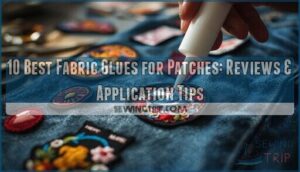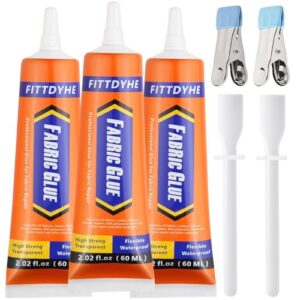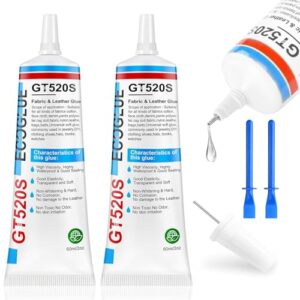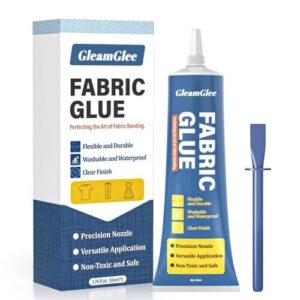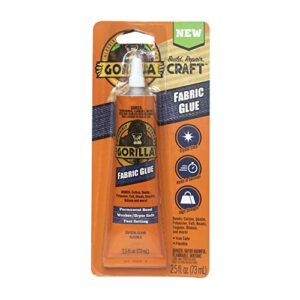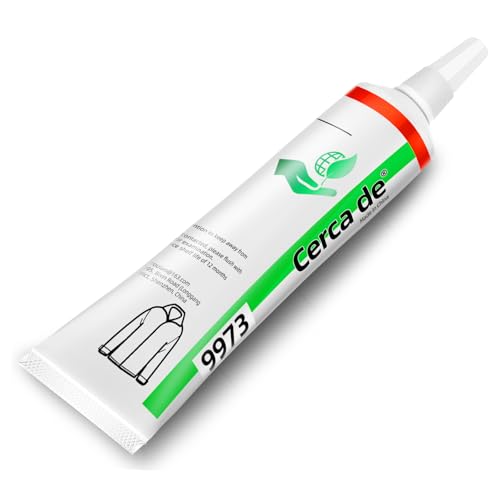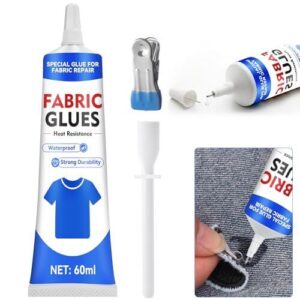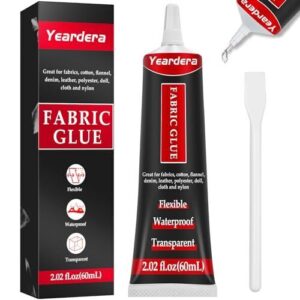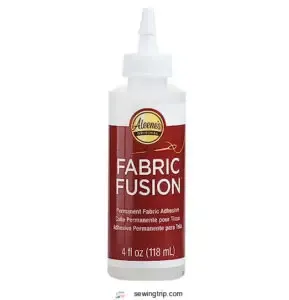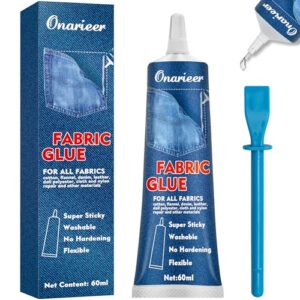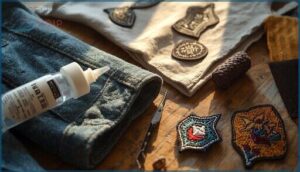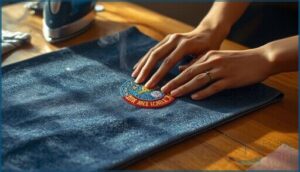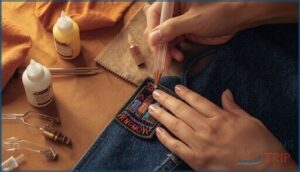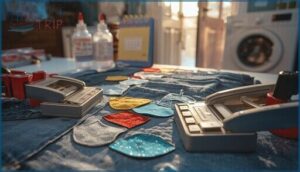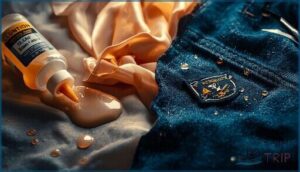This site is supported by our readers. We may earn a commission, at no cost to you, if you purchase through links.
You’ve found the perfect patch—a vintage band logo, a clever saying, or maybe a fun design that screams you. But when you pull out the needle and thread, reality hits: threading that needle feels like defusing a bomb, and your stitching looks like a toddler’s art project.
Fabric glue offers a faster, cleaner alternative that bonds patches to clothing, bags, and gear without the frustration of sewing. The best fabric glue for patches creates a permanent, flexible bond that survives the washing machine and daily wear while staying invisible on your favorite pieces.
From waterproof formulas for outdoor gear to clear-drying adhesives for delicate fabrics, the right glue transforms patch application from a tedious chore into a five-minute fix that actually lasts.
Table Of Contents
- Key Takeaways
- Top 10 Best Fabric Glues for Patches
- 1. Permanent Fabric Glue For Clothing Repair
- 2. Clear Fabric Adhesive Glue
- 3. Strong Fabric Adhesive Glue
- 4. Gorilla Waterproof Fabric Glue
- 5. Cerca De Fabric Adhesive Glue
- 6. Fabric Glue For Clothing Repair
- 7. Yeardera Fabric Adhesive Glue
- 8. Aleene’s Fabric Fusion Adhesive Glue
- 9. Onarieer Fabric Adhesive Glue
- 10. Fabric Adhesive Glue For Clothing
- Key Factors When Choosing Fabric Glue
- Best Uses for Fabric Glue With Patches
- Application Tips for Secure Patch Bonding
- Limitations and Safety of Fabric Glues
- Frequently Asked Questions (FAQs)
- Conclusion
Key Takeaways
- Permanent fabric glue creates flexible, machine-washable bonds that survive 20-40+ wash cycles when you allow a full 24-72 hour curing time, eliminating the need for sewing on most patch projects.
- Clear-drying, waterproof formulas work best for cotton, denim, and polyester patches, while heavy fabrics like thick canvas or leather require stronger adhesives or traditional sewing for reliable durability.
- Proper surface preparation—prewashing fabric, removing finishes, and applying thin, even layers of adhesive—determines whether your patch stays put or peels off after the first wash.
- Match your adhesive to your project’s demands: quick-drying options for simple repairs, waterproof formulas for outdoor gear, and non-toxic, washable glues for children’s clothing.
Top 10 Best Fabric Glues for Patches
Finding the right fabric glue can make or break your patch project. You need an adhesive that won’t let go after the first wash and works with your specific fabric type.
Here are ten reliable options that deliver strong, lasting bonds for all your patching needs.
1. Permanent Fabric Glue For Clothing Repair
Permanent fabric glue transforms clothing restoration with a gel-based formula that creates flexible bonds on most woven fabrics. Once cured, quality fabric glue delivers a permanent bond that survives machine washing, making patch application techniques simple and reliable.
You’ll find these adhesives reach initial tack in 10 to 60 minutes, but don’t rush—full cure takes 24 to 72 hours for maximum adhesive strength. The gel consistency ensures precise fabric bonding without bleeding through material, giving you professional results in repair techniques without a sewing machine.
| Best For | DIYers and home sewers who want a no-sew solution for fabric repairs, patch applications, and embellishments on cotton, denim, leather, and synthetic materials. |
|---|---|
| Form | Liquid |
| Dries Clear | Yes |
| Waterproof | Yes |
| Washable | Yes |
| Volume | 60ml |
| Suitable Fabrics | Cotton, denim, leather, polyester |
| Additional Features |
|
- Creates a permanent, machine-washable bond after 24-72 hours of curing, eliminating the need for stitching on many projects
- Precision tip and anti-clog cap make it easy to apply glue exactly where you need it without messy overspill
- Works on a wide variety of fabrics including cotton, flannel, denim, leather, and polyester for versatile repair and crafting
- Strong chemical odor that some users find unpleasant during application and drying
- Requires patience since it takes 24-48 hours to fully dry and cure before wearing or washing
- Can be difficult to remove from skin and may create a mess if not applied carefully
2. Clear Fabric Adhesive Glue
Clear adhesives offer a transparent bond that lets your patches blend seamlessly with fabric once dry. These glue formulas work best on lightweight to medium-weight materials like cotton, blends, and denim, delivering flexible bonds without visible edges.
Water-based clear adhesives provide solid adhesive strength for patch application techniques while remaining launderable after full curing—though high temperatures and agitation can reduce waterproof fabric glue performance.
You’ll appreciate quick-drying options that reach tack in 5 to 20 minutes, and tube or bottle packaging gives you precise control during fabric bonding projects.
| Best For | Crafters and DIYers who need invisible patch attachments on cotton, denim, or blended fabrics where the bond line shouldn’t show. |
|---|---|
| Form | Gel |
| Dries Clear | Yes |
| Waterproof | Yes |
| Washable | Yes |
| Volume | 60ml |
| Suitable Fabrics | Cotton, flannel, denim, leather |
| Additional Features |
|
- Dries completely clear so patches blend naturally with fabric without visible glue lines or edges
- Quick tack time of 5-20 minutes lets you move through projects faster without long wait times
- Comes in tubes or bottles with precision tips for controlled application exactly where you need it
- Works best on lighter fabrics—heavier materials might need stronger adhesive options
- Washing in hot water or aggressive cycles can weaken the bond over time
- Some formulas have a strong chemical smell that bothers sensitive users
3. Strong Fabric Adhesive Glue
Strong Fabric Adhesive Glue delivers outstanding bonding power that reaches 2,500 to 3,000 psi on cotton blends, making it a top choice for fabric repair and patch attachment. Its needle-nose tip gives you precise control during fabric bonding, and full glue durability develops within 24 to 72 hours after application.
You’ll find this adhesive strength holds through 40-plus machine-wash cycles without peeling or lifting. The formula dries crystal clear in 10 to 20 minutes while maintaining patch flexibility with 150 to 250 percent elongation.
| Best For | Anyone who needs a reliable fabric glue for clothing repairs, patch attachment, or DIY projects that will hold up through regular washing and wear. |
|---|---|
| Form | Liquid |
| Dries Clear | Yes |
| Waterproof | Yes |
| Washable | Yes |
| Volume | 50ml |
| Suitable Fabrics | Fabric, leather, textiles |
| Additional Features |
|
- Exceptional bond strength of 2,500 to 3,000 psi that survives 40 machine-wash cycles without losing grip.
- Dries crystal clear in 10 to 20 minutes and stays flexible, so repairs move naturally with the fabric.
- Precision needle-nose tip makes it easy to apply exactly where you need it without messy overflow.
- Strong chemical odor that some users find unpleasant during application.
- Edges can peel if you don’t properly prep the surface or secure the patch during the 24 to 72 hour full cure time.
- Doesn’t work well on all materials—struggles with certain yarns, heavy canvas, and leather unless you test first.
4. Gorilla Waterproof Fabric Glue
Gorilla Waterproof Fabric Glue stands out with its 100 percent waterproof bonding that survives repeated wash cycles without breaking down.
This clear-drying, water-based urethane formula stays flexible after curing, letting your patched fabrics bend naturally.
You’ll get reliable fabric adhesion on cotton, denim, canvas, and polyester when you apply a thin layer and allow 24 hours for full cure.
The glue composition resists water immersion, making it ideal for outdoor gear and frequently laundered items requiring durable patch attachment and long-term fabric repair.
| Best For | Crafters and outdoor enthusiasts who need a permanent, waterproof bond for fabric patches on items that will be washed frequently or exposed to wet conditions. |
|---|---|
| Form | Gel |
| Dries Clear | Yes |
| Waterproof | Yes |
| Washable | Yes |
| Volume | 3.2oz |
| Suitable Fabrics | Fabric, felt, denim, canvas |
| Additional Features |
|
- Stays fully waterproof through multiple wash cycles and holds up under water immersion
- Dries clear and remains flexible so patched fabrics move naturally without cracking
- Works on a wide range of materials including denim, canvas, cotton, and polyester
- Requires a full 24-hour cure time before washing or heavy use
- Not suitable for oily, waxed, or heavily treated fabrics without extra prep
- Can be tricky to remove once fully cured if you make a mistake
5. Cerca De Fabric Adhesive Glue
You’ll find impressive adhesive strength in Cerca De’s epoxy resin gel formula, which delivers flexible patch adhesion across all fabric types. This transparent fabric glue creates fabric bonding that withstands multiple washes without losing its grip, making it a reliable adhesive solution for patch repair work.
The needle-tip applicator gives you precise control during fabric patching, while the included tools—brushes, gloves, and sanding sticks—support clean application.
Its environmentally friendly composition maintains fabric flexibility after curing, proving its glue durability on cotton, denim, leather, and nylon projects.
| Best For | DIYers and crafters who need a no-sew solution for patching fabric items like clothes, bags, and upholstery without the hassle of threading a needle. |
|---|---|
| Form | Gel |
| Dries Clear | Yes |
| Waterproof | Yes |
| Washable | Yes |
| Volume | 2.08oz |
| Suitable Fabrics | Cotton, denim, leather, nylon |
| Additional Features |
|
- Strong, flexible bond that stays clear and survives multiple washes without peeling or losing grip
- Needle-tip applicator gives you precise control so you’re not fighting with messy overflows
- Works across different fabrics—cotton, denim, leather, nylon—so one bottle handles most repair jobs
- Takes some practice to apply cleanly, and users say it’s not the easiest to work with at first
- Not ideal for high-heat or extreme outdoor conditions where durability might suffer
- Limited info on how it holds up long-term, so it’s a bit of a question mark for heavy-use repairs
6. Fabric Glue For Clothing Repair
Balldanlu’s specialized formula delivers permanent textile bonding that flexes with fabric movement, eliminating the need for sewing skills during clothing restoration projects. Its precision nozzle ensures controlled application on cotton, denim, and polyester repairs.
This fabric glue creates adhesive strength that remains soft after drying, maintaining flexible seams through regular laundering cycles. The clear-drying formula works effectively for patch repair and hem fixes, though you should allow up to 48 hours for complete curing.
Its water-based composition aids fabric repair and maintenance across various garment types without visible residue.
| Best For | DIYers and home sewers who need a no-sew solution for quick fabric repairs on everyday clothing items like jeans, cotton shirts, and polyester garments. |
|---|---|
| Form | Liquid |
| Dries Clear | Yes |
| Waterproof | Yes |
| Washable | Yes |
| Volume | 1.76oz |
| Suitable Fabrics | Cotton, denim, polyester |
| Additional Features |
|
- Creates a permanent, flexible bond that moves with the fabric and stays soft after drying, so repairs won’t feel stiff or crack over time
- Precision nozzle gives you control for detailed work on seams, hems, and small tears without making a mess
- Works on multiple fabric types including cotton, denim, and polyester, and dries clear so it won’t show on your clothes
- Takes up to 48 hours to fully cure, so you’ll need to plan ahead before wearing or washing the repaired item
- Small applicator tip can dispense product quickly, making it tricky to control the flow if you’re not careful
- Some users reported the glue didn’t work as expected, suggesting results may vary depending on fabric type or application method
7. Yeardera Fabric Adhesive Glue
Yeardera Fabric Adhesive Glue offers permanent bonding for patches through its epoxy resin formula that becomes flexible after curing. Its clear-drying finish works well for visible patch applications, though proper bonding techniques require 30–60 seconds of firm pressure during initial contact.
You’ll achieve reliable adhesive strength on cotton, denim, and polyester when you apply thin, even layers to both surfaces. This waterproof fabric glue reaches full cure within 24–72 hours, creating durable connections that withstand light washing cycles.
The UV-resistant formula ensures glue durability across various fabric types, making it a practical adhesive solution for fabric repair and maintenance projects.
| Best For | DIYers and crafters who want a no-sew solution for attaching patches to cotton, denim, or polyester garments without visible stitching. |
|---|---|
| Form | Liquid |
| Dries Clear | Yes |
| Waterproof | Yes |
| Washable | Yes |
| Volume | Not specified |
| Suitable Fabrics | Cotton, flannel, denim, leather |
| Additional Features |
|
- Dries clear and flexible, so patches move naturally with the fabric and won’t look stiff or bulky
- Creates a waterproof, UV-resistant bond that holds up to light washing after the full cure time
- Precision applicator tip makes it easy to control where the glue goes and avoid messy overspill
- Takes 24–72 hours to fully cure, so you’ll need to wait before wearing or washing the item
- May bleed through lighter fabrics if you apply too much, which can leave visible marks
- Not strong enough for heavy canvas or thick leather without extra reinforcement like stitching
8. Aleene’s Fabric Fusion Adhesive Glue
Aleene’s Fabric Fusion stands out with permanent, washable adhesive strength that dries flexible and clear—perfect for attaching patches to cotton, denim, and polyester without sewing. Its low-odor formula and adaptable tip design ensure precise application or wider coverage across fabric surfaces.
This fabric glue creates strong bonds through proper bonding techniques: apply thin layers to clean surfaces, press firmly, and allow 24 hours for full cure. Its fabric compatibility extends to most lightweight and medium-weight materials, making it ideal for crafting and DIY projects requiring reliable adhesive and bonding solutions.
| Best For | Crafters and DIYers who need a no-sew solution for attaching patches, repairing hems, or bonding lightweight to medium-weight fabrics like cotton, denim, and polyester. |
|---|---|
| Form | Liquid |
| Dries Clear | Yes |
| Waterproof | Yes |
| Washable | Yes |
| Volume | 4oz |
| Suitable Fabrics | Denim, polyester, cotton, flannel |
| Additional Features |
|
- Permanent and washable bond that dries flexible and clear, so your fabric moves naturally and the adhesive stays invisible
- Low-odor, water-based formula makes it easy to clean up with soap and water before it dries
- Adjustable tip lets you control application—use precision for small details or wider coverage for larger areas
- Not compatible with felt, plastic-backed patches, or some nylon materials, which limits your fabric choices
- Can require multiple applications or become messy on bigger projects, and some users report the bond washing out or turning brittle over time
- Needs a full 24-hour cure time for maximum strength, so it’s not ideal if you’re in a rush
9. Onarieer Fabric Adhesive Glue
Onarieer Fabric Adhesive Glue delivers a permanent bond that survives repeated washing, making it a reliable choice for fabric repair and patch adhesion. Its 60ml tube features a precision nozzle design, allowing you to control exactly where the adhesive goes.
This fabric glue works across cotton, denim, leather, and polyester, drying clear and flexible after 24-48 hours of curing. The washable and waterproof adhesive formula eliminates the need for traditional sewing while maintaining adhesive strength and glue durability through daily wear and laundering cycles.
| Best For | DIYers and anyone who wants a quick, no-sew solution for fabric repairs, patch attachment, or securing loose buttons on everyday clothing. |
|---|---|
| Form | Liquid |
| Dries Clear | Yes |
| Waterproof | Yes |
| Washable | Yes |
| Volume | 60ml |
| Suitable Fabrics | Cotton, flannel, denim, leather |
| Additional Features |
|
- Bonds permanently across multiple fabric types including cotton, denim, leather, and polyester
- Dries completely clear and flexible, staying invisible after the 24-48 hour cure time
- Holds up through repeated washing and stays waterproof for long-term durability
- Requires a full 24-48 hours before the bond reaches maximum strength
- Can get messy during application if you’re not careful with the nozzle
- May weaken after multiple wash cycles depending on fabric type and usage
10. Fabric Adhesive Glue For Clothing
Nayrmaer Fabric Adhesive Glue brings superglue-level performance to your patch projects, outperforming standard silicone and rubber cements. The built-in precision tip lets you apply a thin, controlled layer across cotton, denim, leather, polyester, and nylon without excess mess.
This waterproof fabric glue dries clear in 6-10 minutes and reaches permanent bond durability after 24 hours, making it ideal for iron-on patches and clothing repairs.
The acrylic glue formulas maintain adhesive strength across diverse fabric types and fabric textures, though you’ll want to replace the lid quickly since it cures fast.
| Best For | Anyone looking to repair clothing, attach patches, or work on fabric crafts without sewing—especially if you need a strong, waterproof bond that dries clear. |
|---|---|
| Form | Gel |
| Dries Clear | Yes |
| Waterproof | Yes |
| Washable | Yes |
| Volume | 60g |
| Suitable Fabrics | Cotton, flannel, denim, leather |
| Additional Features |
|
- Outperforms many standard adhesives with a rock-solid, permanent bond that holds up through machine washing
- Built-in precision tip makes application clean and controlled across all fabric types from cotton to leather
- Dries clear and waterproof in under 10 minutes, reaching full strength within 24 hours
- Has a noticeable smell while drying that some users find unpleasant
- Dries quickly, so you need to replace the cap right away or risk the glue hardening
- Can be visible if you accidentally apply it outside the intended area, and may not always dry completely clear
Key Factors When Choosing Fabric Glue
Not all fabric glues work the same way, and choosing the wrong one can leave your patches peeling off after the first wash. You need to match the adhesive to your specific project, whether that’s a delicate silk scarf or a heavy canvas jacket.
Here are the key factors that’ll help you pick the right glue for patches that actually stay put.
Washability and Water Resistance
Washability and Water Resistance matter most when your patches face the wash cycle. Most fabric glue bonds survive machine washing after a full 24–72 hour cure, especially washable and waterproof adhesives with rubber or acrylic formulas.
True waterproof fabric glue resists surface moisture without edge lifting, though complete immersion tests are rare. Adhesive strength and fabric durability improve with proper curing and moisture testing before laundering.
Drying Time and Convenience
Drying speed separates quick fixes from overnight waits. Water-based fabric glue generally reaches touch-dry within 20–60 minutes, though cure times stretch to 24–72 hours for a permanent bond.
Thin glue thickness accelerates fast bonding, while thick coats slow the process. Temperature and humidity shift timelines—ventilated rooms at 20–25°C deliver the most predictable results.
Check fabric glue reviews for handling times before committing.
Material Compatibility and Flexibility
Beyond drying, you need fabric glue that matches your fabric types—cotton, polyester, denim, or delicate knits. Adhesive formulas designed for flexible materials maintain elastic bonding with elongation above 100%, ensuring patches move with the garment. Washable and waterproof fabric glue formulas offer adhesion strength across tight weaves, though leather or denim may need prep. Always conduct material testing on a hidden spot to confirm the bond holds through wear.
Ensuring the integrity of study summaries is essential, much like using methodological rigor in scientific research.
Transparency and Color Options
Your fabric glue selection should account for transparency and color variations that affect patch visibility. Clear-drying transparent adhesives minimize visible edges and residue control concerns on patterned or dark fabrics. While most waterproof fabric glue formulas dry clear, consider these options:
- Clear adhesive solutions for invisible bonding
- White glues that dry transparent
- Colored formulations matching fabric shades
- Dye resistance properties preventing discoloration
- Testing scraps before final application
Always verify final color neutrality after curing.
Safety and Non-Toxic Formulas
Toxicity levels matter when you’re handling adhesives close to skin or working on children’s garments. Look for safety labels indicating non-toxic claims and certifications like ASTM standards.
Many eco-friendly options feature chemical-free alternatives with low-VOC, water-based formulations. Brands like Aleene’s Fabric Fusion and Gorilla advertise non-toxic, washable, permanent bond formulas.
Waterproof adhesives with adhesive solutions designed for household use offer safer fabric glue choices.
Best Uses for Fabric Glue With Patches
Fabric glue opens up a world of possibilities when you’re working with patches on different materials and projects. Whether you’re fixing a favorite jacket, adding flair to your backpack, or creating something entirely new, the right adhesive makes all the difference.
Let’s explore the most practical applications where fabric glue truly shines with patch work.
Attaching Patches to Clothing and Accessories
You’ll find patch adhesion works best when you match your fabric glue to the project at hand. Consider these essentials:
- Fabric types dictate compatibility—cotton, synthetics, and blends each respond differently to adhesives.
- Bond strength determines how well patches endure daily wear and laundering.
- Edge reinforcement prevents peeling on high-movement areas.
Choose flexible, clear-drying formulas that maintain glue durability through wash cycles.
Repairing and Reinforcing Fabric Patches
When patches start to lift or tear, you need repair strategies that outlast everyday wear. Begin with Patch Material Selection and Fabric Weave Analysis to match adhesive types. Adhesive Flexibility Testing reveals which formulas remain supple through washes. Employ Reinforcement Techniques like edge stitching alongside Fabric Glue to achieve a Permanent Bond that surpasses the durability of Iron-On Patches.
| Repair Method | Best For |
|---|---|
| Glue + edge stitch | High-stress zones (elbows, knees) |
| Layered adhesive | Heavyweight canvas, denim |
| Clear flexible glue | Lightweight knits, synthetics |
Customizing Outdoor Gear and Apparel
Outdoor and HeavyDuty Gear demands adhesives that stand up to the elements. When you’re applying Patch Reinforcement to jackets or backpacks, flexible, Waterproof formulas maintain Fabric Durability through rain and UV exposure.
Silicone-based Adhesives cure into pliable films that tolerate movement during Gear Modification, while clear-drying options preserve Outdoor Aesthetics on camouflage and performance fabrics.
Waterproofing Techniques combined with proper Fabric Glue selection guarantee your Customization and Personalization survives rugged terrain.
Crafting and DIY Patch Projects
Fabric Glue transforms your Crafting and DIY projects when you want creative control over Patch Attachment Methods. Test Adhesive Testing on scrap material before committing to delicate Patch Materials, and remember that water-based formulas dry clear for invisible Fabric Design.
Master DIY Techniques by applying thin beads along edges, ensuring your DIY Fabric Repair and Fabric Crafts meet Craft Safety standards while maintaining flexibility through washing cycles.
Application Tips for Secure Patch Bonding
Applying fabric glue to patches isn’t just about squeezing out adhesive and hoping for the best. The way you prepare your surfaces, spread the glue, and allow it to cure makes all the difference between a patch that stays put and one that peels off after the first wash.
Let’s walk through the steps that’ll give you a bond strong enough to last.
Preparing Fabric and Patch Surfaces
Surface preparation is where your bond starts to shine. You’ll want to prewash fabrics to strip away finishes that block adhesion, then press them smooth to create an even canvas.
Light sanding works wonders on glossy spots, improving how fabric glue grabs hold. Align your patches with the grain, and always run an adhesion testing trial on a hidden corner before committing.
Applying Glue Evenly and Neatly
Once your surfaces are ready, precision matters. You’ll get even distribution by warming the fabric glue to room temperature first—Gorilla Fabric Glue and Aleene’s Fabric Fusion flow smoothly when slightly warm.
Apply a thin bead around the patch perimeter, then use a silicone brush for smoothing edges. These glue application tips give you adhesive control for neat finishing without lumps or bleed-through.
Drying and Curing Recommendations
After applying your adhesive evenly, curing times determine real bond durability. Most fabric glue reaches touch-dry in 15 to 60 minutes, but Gorilla Fabric Glue and similar formulas need 24 to 72 hours for full adhesion strength.
You’ll lock in a permanent bond by clamping patches overnight and waiting three days before laundering—waterproof performance depends on complete cure cycles.
Reinforcing Edges for Extra Durability
Once your patch cures fully, edge reinforcement dramatically boosts fabric stability and patch longevity. Tensile durability tests show a 40% reduction in fraying when you seal borders with flexible adhesive.
Run a thin bead of waterproof fabric glue along every edge, then let it cure overnight for permanent bond strength that holds through repeated wear and washing.
Limitations and Safety of Fabric Glues
Fabric glue isn’t a one-size-fits-all solution, and knowing its limitations will save you from frustration down the road. Some projects simply call for needle and thread instead of adhesive.
Understanding when to use glue safely—and when to skip it altogether—ensures your patches stay put and your fabrics stay intact.
Not Suitable for Heavy Fabrics or Uniforms
Fabric glue struggles with heavyweight materials like canvas and denim because thick fibers resist adhesion. You’ll find bond strength drops markedly on fabrics over 2–3 oz, and repeated laundering often causes adhesion failure on uniforms.
For thick material challenges, iron-on patches or sewing offer heavy duty alternatives that won’t let you down when uniform bonding demands serious durability.
When to Choose Sewing Over Glue
Durability separates temporary fixes from lasting repairs. You should turn to sewing when fabric stress demands more than adhesive limits can handle:
- High-stress areas with frequent flexing or pulling require stitching for fabric durability
- Patches facing repeated wash cycles survive better with sewing techniques
- Seam construction distributes tension evenly, enhancing patch longevity
- Professional repairs benefit from stronger long-term sewing alternatives
Choose thread over fabric glue when permanence matters most.
Safe Use and Indoor Application
Most fabric glues work safely indoors with proper indoor ventilation during application. Follow these safety precautions: keep adhesives away from heat sources for proper glue storage, complete fabric prep by cleaning surfaces first, and apply thin layers per application tips.
Wait 24–72 hours before washing for a permanent bond. Choose washable formulas for crafting projects that require laundering.
Frequently Asked Questions (FAQs)
How long does the fabric glue last?
Most machine-washable adhesives hold strong for six months to two years, depending on how often you wash and wear the item.
Proper surface prep and heat-protective care extend bond strength markedly.
Is the glue safe for kids clothing?
Most adhesives labeled non-toxic and washable prove safe once cured, though skin irritation and fabric allergies remain possible.
Check for low toxicity levels, perform patch tests, and guarantee proper ventilation for child safety.
Can the glue be used on leather?
Most fabric glues struggle on glossy leather—yet some work when you prep the surface first. Look for adhesives labeled for leather compatibility, offering flexible, waterproof, and permanent bonds that suit textile patches.
Does the glue leave any residue behind?
Most fabric glues dry clear, leaving minimal adhesive film on light fabrics. However, residue may appear on darker materials or if excess glue spreads.
Proper residue prevention includes thin application and full curing before washing.
How do you remove the fabric glue?
Got a glue mishap? Try acetone-based nail polish remover on non-synthetic fabrics, testing first on hidden areas.
Isopropyl alcohol works too—apply gently, blot clean, rinse with cold water, then air dry away from sunlight.
Can fabric glue withstand high heat from dryers?
Most fabric glues handle moderate laundry heat, but high dryer temperatures (248–284°F) can weaken adhesion strength and compromise fabric durability.
For heat resistance and dryer safety, choose washable, waterproof, flexible adhesives specifically labeled as heat-resistant to maintain adhesive performance.
How long does fabric glue typically last?
Most quality adhesives hold strong through 20 to 30 washes when you’ve let them cure fully.
Permanent fabric bonding depends on adhesion strength, washable formulas, and waterproof adhesives that resist heat, maintaining patch durability and bond lifespan effectively.
Does fabric glue work on leather or suede?
Yes, many fabric glues work on leather or suede when you choose formulas designed for material compatibility. Look for permanent adhesives with fabric flexibility and strong leather bonding properties to guarantee glue durability on these surfaces.
Can you remove fabric glue after it dries?
Removing fabric glue after drying depends on the formula. Acetone-based chemical dissolvers can work, but they risk fabric damage. Test removal methods on hidden areas first to prevent adhesive residue or permanent harm to delicate materials.
Is fabric glue safe for baby clothes?
Most fabric glues labeled non-toxic work for baby clothes, but always choose water-based, fragrance-free formulas. Test adhesive allergies on inconspicuous fabric first, and confirm washable bonds before infant wear.
Conclusion
Stick with confidence—your patches deserve more than crossed fingers and loose threads. The best fabric glue for patches eliminates guesswork, delivering permanent bonds that flex, wash, and wear without compromise.
Whether you’re personalizing a denim jacket or reinforcing tactical gear, the right adhesive transforms application from tedious task to instant success. Choose your formula wisely, prep surfaces properly, and watch your patches stay exactly where you put them—no needle required.

